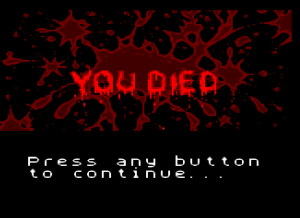Death is everywhere and nowhere in digital games.
Videogame detractors have pointed to vivid depictions of violent deaths in shooters and brawlers as evidence of the medium’s depravity, but – for most players – digital deaths are straightforward components in a game’s feedback loop: killing and dying are simply conventional metaphors for winning and losing. In this way, death in videogames is both hypervisible and hardly seen.

There is a long history of videogames using death to signal defeat. In 1962, for example, the now iconic game Spacewar! simulated a dogfight between two rival spacecrafts, wherein victory entailed destroying your opponent’s ship whilst avoiding lethal collisions with stars and space debris. As gaming technology has evolved over time, some digital deaths have become more graphic and visceral, but their symbolic function has remained the same. Slow-motion headshots or grisly fatalities are still used as measures of the player’s mastery. On-screen deaths are essentially audiovisual acknowledgements of the player’s input, and the addition of some excessive enemy blood spatter amounts to the aesthetic equivalent of high score. While there are, of course, many contemporary videogames that take place in deathless worlds, dying has become an accepted shorthand for ludic failure.
Digital deaths in games serve both as penalties and as pedagogic tools: they simultaneously enforce the game’s rules and train players to master these rules. When players misjudge a jump, or are outmanoeuvred by an enemy, or their allotted time runs out, they expect to witness their avatar’s demise and to experience death as a brief break from play – nothing more than a hiccup, a temporary setback. In the age of arcade cabinets, death could be surmounted with a few coins for the ferryman. Nowadays, digital deaths cost even less. Regular autosaves and copious spawn points are the new standard, so play is only ever paused by death for a matter of moments. Some game genres do feature ‘permadeath’ mechanics, but these rare exceptions prove the rule. For the most part, when players die, they may lose time, and – if they’re playing for an audience – lose face, but usually death means a second chance.
Digital deaths are normalised and routinised to the point that most players find them unremarkable. Even when games depict a variety of entertaining ways in which one’s avatar can shuffle off its mortal coil, players are easily habituated to dying – in fact, many games encourage the reckless sacrificing of the avatar’s body in the name of playful experimentation. One could conclude that the shallow and superficial nature of most digital deaths means videogames aren’t worthy of inclusion in serious debates about contemporary attitudes towards mortality. However, one could also make the case that the apparent trivialisation of death in videogames reflects a core tension in current Western representations of death. Across popular media, death is either staged as a shocking spectacle or it is euphemistically elided, but in videogames it is often both things at once. In fact, videogames bring to the fore some of the ideological underpinnings of our society’s relationship with death, specifically the ways in which death is considered a fail state and something that must be overcome.
What is more, there are a growing number of videogames that move beyond the idea of a death as a mechanic and instead meditate on death as a social, emotional, and biological event. Games like Gris (Nomada Studios) and What Remains of Edith Finch (Giant Sparrow) use the medium’s interactivity to find new metaphors to explore and explain mortality. Brothers: A Tale of Two Sons makes the most of the embodied nature of gaming to offer players a somatic experience of bereavement. Spiritfarer (Thunder Lotus) and To the Moon (Freebird Games) provide alternative ways to think about end-of-life care, while A Mortician’s Tale (Laundry Bear Games) reveals the practical and emotional rituals surrounding the bodies of the recently deceased. There are autobiographical games such as That Dragon, Cancer (Numinous Games) and Mandagon (Blind Sky Studios) that intimately record the grieving process, and games such as Passage (Jason Roher) and Journey (ThatGameCompany) that position dying as the interpretive key to understanding life.

In this new series of Reflections, Emma Reay will examine a selection of contemporary videogames that speak to some of the concerns at the heart of the Death Positivity movement. Proponents of Death Positivity seek to normalise and demystify death by encouraging open, honest discussions about mortality. Videogames are an important part of these discussions – not just because they dominate modern media ecosystems, but also because they provide a new language to communicate ideas about death. This language combines rules-based interactions with haptic gestures to offer a different vocabulary to describe our shared vulnerability, impermanence, and corporeality.
Posted: